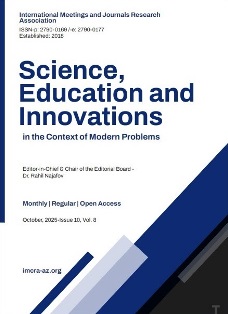Author Guidelines
General
✅ Recommended Article Structure (International Format)
Each article should follow a clear and standardized academic structure:
1. Title
-
Concise and informative
-
Avoid abbreviations
-
Font: Bold, size 14–16 pt
2. Author Information
-
Full names of all authors
-
Institutional affiliations (department, university, city, country)
-
ORCID IDs (optional but recommended)
-
Email of corresponding author (marked with *)
3. Abstract (150–250 words)
-
Clear summary of background, objectives, methods, results, and conclusion
-
In English (even if article is in another language)
-
Italicized or formatted distinctly
4. Keywords (4–6)
-
Alphabetical order
-
Separated by semicolons or commas
-
Use terms indexed in databases (e.g., Scopus, JEL for economics)
📖 Main Body Structure (IMRaD Format Recommended)
1. Introduction
-
Research background and relevance
-
Research question or aim
-
Literature review (brief)
2. Methods / Methodology
-
Detailed explanation of research methods
-
Study design, tools, sample size, etc.
3. Results
-
Tables and figures must be numbered and captioned
-
Use professional formatting (centered, clear labels, source indicated)
4. Discussion
-
Interpretation of results
-
Comparison with other studies
-
Implications, strengths, limitations
5. Conclusion
-
Summarize findings
-
Suggest policy, theoretical, or practical implications
-
Optional: Suggestions for future research
📚 Additional Sections
6. Acknowledgments (if applicable)
-
Funding agencies, contributors, etc.
7. References
-
Use APA 7th edition or another internationally accepted citation style (Harvard, Chicago, etc.)
-
All sources must be cited in-text and in the reference list
-
Use proper formatting tools (Zotero, Mendeley)
🔎 Example APA:
Smith, J. (2023). Education innovation in digital age. Journal of Learning Studies, 12(3), 45–60. https://doi.org/10.1234/jls.v12i3.4567
🧾 Technical Formatting
| Element | Recommendation |
|---|---|
| Page Size | A4 |
| Margins | 2 cm on all sides |
| Font | Times New Roman, 12 pt |
| Spacing | 1.5 or Double spacing |
| Paragraphs | Justified; indent first line or use spacing between |
| Page Numbers | Do not include (journal adds them later) |
| Language | Academic English or French (must include English abstract) |
✅ Final Checks Before Submission
-
Proofread for grammar, clarity, and formatting consistency
-
Run plagiarism check (Turnitin or iThenticate recommended)
-
Ensure JEL codes are added (for economics articles)
-
Convert to PDF + DOCX formats
Special for SEI Joruna;
1. Languages Accepted
-
Articles are accepted in English and French.
-
All submissions must include the title, abstract, and keywords in English, regardless of the original language.
2. General Requirements
-
Articles must be original, relevant to the journal's scope, and follow accepted academic standards.
-
No restrictions are imposed on topics, provided they fall within the journal’s aims.
-
For economics articles, JEL classification codes must be indicated.
-
Do not include page numbers in your manuscript.
3. Graphics and Illustrations
-
Use MS Excel for charts/graphs.
-
Charts made in other programs must be saved in vector formats (*.pdf, *.eps, *.ai, *.cdr).
-
All numerical data used in images must be included in the file.
4. References Format (APA 7)
-
Only cite academic and scientific sources (books, peer-reviewed journals, etc.) from the last 5–10 years.
-
In-text citations: Author, year – e.g., (Mammadov, 1964)
-
Reference list: Arabic numerals, in order of appearance, not alphabetical.
Books
-
Format: Author(s). (Year). Title. Place: Publisher.
-
Example: Wilkinson, I. (2017). Oxford Handbook of Clinical Medicine. Oxford: Oxford Press.
Edited Books
-
Format: Editor(s). (Ed.). (Year). Title. Place: Publisher.
-
Example: Norman, I.J., & Redfern, S.J. (Eds.). (1996). Psychological Help for the Elderly. New York: Churchill Livingston.
Journal Articles
-
Format: Author(s). (Year). Article title. Journal Name, volume(issue), page numbers. https://doi.org/xxx
-
Example: Vega, K. (1996). Heart transplantation is associated with... Annals of Internal Medicine, 124(11), 962–980. https://doi.org/10.7326/0003-4819...
Conference Proceedings
-
Format: Author(s). (Year). Title. Conference Name, location.
-
Example: Chu, H., & Rosenthal, M. (1996). Search Engines for... 1996 ASIS Annual Meeting, Baltimore.
Electronic Sources
-
Format: Author(s). (Year). Title. Source/Journal Name, volume(issue), pages. Retrieved from URL
-
Example: Duchin, J.S. (2004). Can Biological Terrorism... Arch Pediatr Adolesc Med, 158(2), 106–107. Available at: http://archpedi...
Russian-Language Sources
-
Use BSI transliteration: https://antropophob.ru/utility-i-prochie-melochi/16-transliteratsiya-bsi
-
Add “(In Russ.)” after the citation.
-
Example: Mammadzadeh, A.V. (2018). Pryamye inostrannye investitsii... M.: Knorus. (In Russ.)
Note: Dissertations and abstracts are not recommended as sources. Authors are encouraged to cite published works based on the dissertation.
For questions regarding formatting, submission, or citations, please contact the editorial board via editor@imcra-az.org.


















